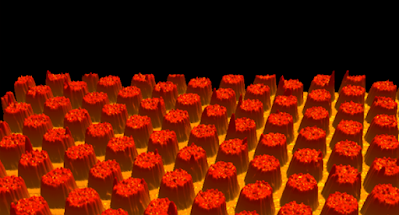There are times when superconductors materials through which electric current can travel without resistance and thus without losing energy don’t live up to their reputation. Nadya Mason of the University of Illinois at Urbana-Champaign has been making strides toward understanding when and how electron energy loss, or dissipation, arises in otherwise superconducting systems. She had planned to share this work in the Edward A. Bouchet Award Talk at the March Meeting of the American Physical Society earlier this month. (The meeting was canceled due to concerns about the new coronavirus disease, COVID-19, but Physics is reporting on some of the results that would have been presented.)
Nadya Mason and her team study superconducting “nanoislands” on metallic surfaces to understand how dissipation arises in nonuniform superconductors.
Modern technology is largely based on normal conductors, but electrical currents in these materials always dissipate some energy as heat. “Superconductors give us a great opportunity to save energy by reducing dissipation,” Mason says. “But in order to use superconductors, we have to understand how dissipation affects them in particular, and how to minimize [dissipation] and control it.”
A superconducting system acts as a normal conductor at high temperatures, but when the material drops below some transition temperature, its resistance drops as well. In a standard superconductor, the resistance would drop to zero. But in some superconducting systems, such as thin films of niobium-silicon alloy, the resistance drops for a while with decreasing temperature but flattens out at some finite value before reaching zero. This means that some superconducting systems have dissipative, metallic states even in what would conventionally be a superconducting regime.
Researchers don’t yet understand what causes dissipation in these systems, but Mason hopes her work with nanofabricated materials might provide some insight. She’s explored how dissipation arises and behaves in “hybrid” superconductor-normal systems—materials with nonuniform mixtures of superconducting and normal metallic components. Researchers have speculated that dissipative systems such as niobium-silicon-alloy films may also have distinct metallic and superconducting regions. But if these metallic regions exist, they would be too small to examine directly. So Mason and her research team create their own model hybrid systems, in which they can control and vary factors such as the distribution of superconducting and metallic parts and the strengths of magnetic fields.
A few years ago, Mason’s team started experimenting with a model hybrid system composed of “nanoislands” of superconducting material on films of normal conducting material, such as graphene or gold. In the past, other researchers had run experiments using a “superconductor sandwich”—two layers of superconducting material with a sheet of normal conductors between them. In this configuration, the material inside the sandwich can gain some superconducting properties as electrons and holes bounce between the two superconducting layers without resistance. In technical terms, this sandwich is called a superconducting junction. Each of Mason’s arrays of superconducting islands on a conductor has so many of these junctions that it approximates a single, continuous material.
With the arrays, Mason’s team could manipulate parameters, such as the spacing between islands, to study how these parameters affect transitions between superconducting and normal metallic behavior. The team found that the spacing did indeed effect when the system was metallic or superconducting; systems with larger spacings had metallic states while systems with smaller spacings did not.
“This [behavior] is one of the things that tell us that perhaps these unusual dissipative superconducting states could be related to a mixture of superconducting and metallic states happening at microscopic scales inside materials,” Mason says.
Earlier this year, Mason published new work on another model hybrid system made of superconducting and metallic materials. In that study, Mason’s team investigated a single island, made up of a jumbled mix of superconducting and normal metallic grains of material. Unlike the past work, which focused on an ordered array of islands embedded in a metallic sheet, this experiment probed a disordered system. The main finding from this study, Mason says, was that the size of the largest grain in a single jumbled mixture determined the superconducting transition temperature. Previously, researchers thought that it was probably the density of grains that mattered in a system like this and didn’t realize the role of grain size.
Now, Mason’s team is moving beyond the small, single-island disordered system and introducing disorder into the previous experimental setup of arrays of superconducting islands.
“We're taking something that's really hard to understand and control—this idea of disorder—and creating a system where you can really control it in a new way,” Mason says. (Indrawan Vpp)



















